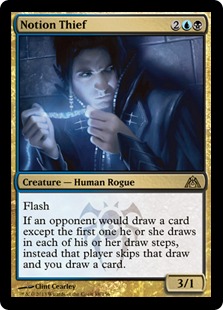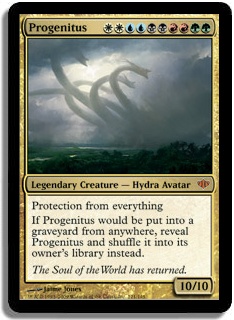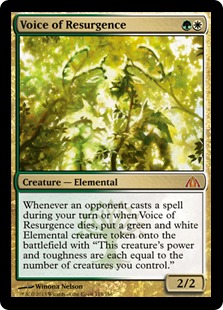Legacy Weapons
Alright. I’m just going to say it.
The lack of SCG Legacy Opens over the last few weeks has been pretty disheartening.
I love Legacy. There are not a whole lot of things I like better than casting powerful spells and being able to interact with my opponent on an entirely different level than any other format. Force of Will keeps a lot of the more degenerate decks in check and allows for a robust, diverse metagame. Legacy is by far the most skill-intensive Constructed Magic format, and I am always excited by the prospect of filling my Sunday afternoon with putting some Griselbrands into play.
This weekend the StarCityGames.com Open Series is coming to Baltimore, and it will feature Legacy. I’m incredibly happy that I’m going because I haven’t gotten to play Legacy in quite a while; I’m ready to try out some new ideas, as well as a few old ones. The format seems to be changing rather quickly from event to event, with a variety of decks coming out on top each time.
In the past few months, we’ve seen a decline in RUG Delver. I’m pretty content with this development since RUG Delver can be one of the most frustrating decks to play against regardless of what you bring to the table. Sure, the match is usually pretty skill-intensive, but there are a lot of games that just go Delver of Secrets into Wasteland + Daze, resulting in game over. I’m no stranger to a blowout of a game from either side, but the amount of cheap disruption that RUG Delver has access to can be overwhelming for newer and seasoned players alike.
Without RUG Delver on the block, what does that mean for your average player? For one, it opens up a lot of prospects for other decks to shine—namely combo decks. When you don’t have to be terrified of Daze and Spell Pierce, the world is your oyster. With that said, there are still a lot of Force of Will decks running around, so don’t expect to get a lot of free wins out of the rest of the field. Most players will come with a plan prepared for whatever the format can throw at them, so you’re rarely going to catch someone off-guard.
Deathblade Is Best Blade
As for the current best deck in the format, I think Brian Braun-Duin Esper Deathblade list has a lot of promise. In the hands of two grizzled veterans of the Open Series, it made for a mirror match in the finals of SCG Legacy Open: Nashville just a short time ago. Here is Lauren Nolen take on the deck:
Creatures (16)
- 4 Dark Confidant
- 1 Vendilion Clique
- 4 Stoneforge Mystic
- 2 Snapcaster Mage
- 4 Deathrite Shaman
- 1 Notion Thief
Planeswalkers (3)
Lands (23)
Spells (18)

Brian Braun-Duin built this version of the classic Esper Stoneblade deck a couple months ago before the StarCityGames.com Invitational in Atlanta. Deathrite Shaman has been making waves in various archetypes since its release, and the fact that a non-green deck is doing good work with the little guy says a lot. Of course, there is a "splash" for Tropical Island so you can activate the gain life ability, but you rarely see decks that play a land that doesn’t physically cast any of their spells.
What Deathrite Shaman does is give the deck resilience to Wasteland while also preventing a ton of graveyard shenanigans from the opponent. The ability to add a Birds of Paradise to a midrange control deck without access to green mana is impressive and gives you a lot of acceleration in matchups where it matters. An early Jace, the Mind Sculptor or just being able to play two spells in one turn can be monumental in Legacy.
As you can see, Nolen decided to make some creative changes to BBD’s decklist. The most entertaining of these changes by far was the Notion Thief in the maindeck. After seeing Justin Uppal childhood end on camera when a Jace, the Mind Sculptor activation backfired, I was definitely intrigued. I’m not certain that Notion Thief actually deserves a slot in the deck, but it was pretty fun regardless.
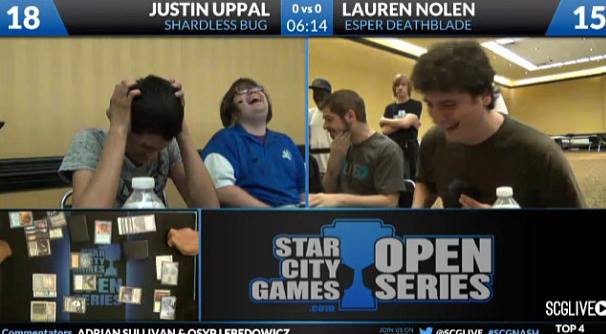
Someone is certainly having fun here.
I’m not certain of the best list, but I do like the direction that Nolen took the deck. Originally, BBD relegated Force of Will to the sideboard since the Invitational is notorious for having fewer combo decks than your average Legacy Open. It seems only natural that Nolen put them back into the maindeck for the Open in Nashville. In our new column Leaving a Legacy last week, he stated that Force of Will is potentially best left in the sideboard, but I just don’t see it.
From my experience, you play against a fairly wide variety of decks in Legacy. Sure, there are a decent number of opponents who play cards that make your Force of Wills actively bad, but I just feel naked when playing without it against a combo opponent. Without Force of Will, you have to rely solely on your discard effects to interact with them in the first game, and I honestly don’t think you have much of a chance to defeat something like Show and Tell without it. Discard is rarely enough when the opponent has enough time and card selection to eventually find their combo pieces. I think playing Esper Deathblade in an Open without Force of Will is pretty silly.
The other side of the coin is that you side out Force of Will pretty often against a lot of decks. This is because the cards you’re sideboarding into are often more proactive than the ones you’re siding out, making Force of Will a little bit worse. Force of Will is also pretty miserable against any deck playing Aether Vial and is terrible in matchups where attrition actually matters. Sure, you will want Force of Will against a variety of combo and control decks, but it won’t always be castable and won’t always be advantageous even when you do cast it. Two-for-ones are always a pain in Legacy due to the lack of raw card advantage spells that are playable, so falling behind on cards is a thing that happens quite often. Force of Will only exacerbates this problem.
Sarah Palin Special
I’ve been around the block a bit in Legacy. These are the different archetypes I’ve explored over the last few years on the Open Series:
Reanimator
Sneak and Show
RUG Delver
Maverick
Punishing Counterbalance
Storm
Shardless BUG / BUG Control
Goblins
Merfolk
NO RUG
NO Bant
U/W Stoneblade / Esper Stoneblade
And a few others that I’m sure I’m forgetting. I have some experience with a variety of archetypes, and I’m no stranger to watching interesting interactions between certain matchups. I know what is generally good and bad in a multitude of situations, and I try to use that information to capitalize in future tournaments. I’ve tried my best to make all these archetypes work, though some didn’t work exactly as I expected them to. I’ve had reasonable success with a few of these archetypes, but the one that I had the most fun playing with was Maverick. I think this is due to the nature of the beast.
At its heart, Maverick is an interactive deck. You are playing cards that are built to even the playing field between you and your opponent so that they have to play your game. Thalia, Guardian of Thraben was an absurd addition to the deck, giving you a cheap way to interact with a lot of the combo decks in the format as well as a disruptive threat to tag-team with Wasteland. Thalia was just an absolute beating against decks like RUG Delver, and I can only assume she is just as much of a pain now as she was a few months ago.
Looking over the decklists from the most recent Legacy Opens, I don’t really see a lot of decks I would be actively afraid to play against with Maverick. Since you aren’t playing Force of Will, there’s always the chance that the combo decks will be able to punish you early in the game before you can develop some of your disruptive elements, which has always been a problem for green decks. This is mitigated by playing two-drops that are nearly unbeatable for some of the archetypes, but the danger is always there. One of the most frustrating things to play against from the Maverick side of things is Goblin Charbelcher or equally fast decks whose goal is to limit interaction as much as possible.
 |
vs. |
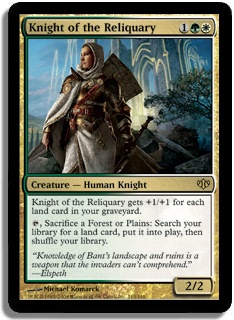 |
Dayv Doberne recently made it to the finals of the SCG Legacy Open in Seattle with his take on Maverick. His list looked pretty sweet, but there are a few hiccups.
Creatures (21)
- 4 Mother of Runes
- 2 Birds of Paradise
- 1 Scryb Ranger
- 1 Gaddock Teeg
- 4 Knight of the Reliquary
- 2 Qasali Pridemage
- 2 Stoneforge Mystic
- 2 Scavenging Ooze
- 3 Deathrite Shaman
Lands (24)
Spells (15)

The addition of Deathrite Shaman to the mix gives you a bit more play against graveyard-based combo decks, but I’m not sold on its inclusion in Maverick. Most of the time, you’re exiling your own lands with Deathrite Shaman’s ability, which can hinder the growth of your Knight of the Reliquary. The power level of Deathrite Shaman might override this nonbo, but you always want your deck to fire on all cylinders. Without positive synergy, it is very easy for a lot of decks in Legacy to outclass you in a hurry.
I would not be unhappy to play a single Deathrite Shaman to tutor up with Green Sun’s Zenith in matchups where I might need a mana accelerator or potential answer to graveyard shenanigans, though Scavenging Ooze fills the second role in a much stronger way.
Adding another color into the mix, Dayv decided to play a full set of Thoughtseizes in the maindeck. This gave him a little more action against the combo decks and was probably the reason he was able to navigate through the field so easily. Maverick hasn’t really been a player as of late, but the innovation to an old favorite of mine definitely caught my eye. Abrupt Decay out of the sideboard, as well as a few others cards, seemed like upgrades for a very small cost. Older versions of Maverick played a ton of basic lands in order to play around opposing Wastelands, but I don’t know if that is even necessary at the moment. I think one or two basic lands would suffice considering the bevy of mana sources you have at your disposal.
The price of playing more spells like Thoughtseize in your deck is that you have to make room somewhere! Dayv decided to cut Thalia, Guardian of Thraben from the deck, which is not something I agree with in the slightest. Thalia is legendary, so it’s pretty weak against anyone willing to play multiple copies of Karakas, and it also makes a lot of your hands pretty awkward when you draw multiples. That being said, I’m personally biased in favor of the card. I don’t think my judgment is entirely sound, but I believe that Thalia is one of the main reasons to play Maverick in the first place!
One thing Maverick does have at its disposal is Natural Order. While I’m not certain it should be included in the maindeck, I think putting a Progenitus into play is incredibly difficult for many decks in Legacy to deal with currently. As a sideboard option, it doesn’t take up too many slots, but drawing Progenitus could be catastrophic since you don’t have Brainstorm to shuffle it back into your deck. However, the upside of dominating other fair decks is too strong to dismiss, and I think it is a risk worth taking.
Natural Order also gives you access to a few big bombs that can assist in matchups that are a bit more difficult like Tezzeret and Enchantress. These are the kind of decks you hate playing against because they’re able to assemble a large quantity of annoying artifacts or enchantments that prevent you from winning the game. Having something like Terastodon to break through can be a sweet addition to the Natural Order package, which takes up few slots in the sideboard.
At the moment, Voice of Resurgence is the talk of the town in Standard. I think that Maverick could gain a reasonable boost from playing such a strong, cheap creature. While the premier removal spell in Legacy is Swords to Plowshares, there are a lot of decks that can’t really function against a Voice of Resurgence. I think that RUG Delver will struggle with the card pretty significantly since both halves of Voice can be problematic. Not only do they not have a great way to deal with a 4/4+ Elemental token, but turning off all their cheap disruption is a huge plus.
The only downside to Voice of Resurgence is that it is just a Grizzly Bear in a number of matchups. Unfortunately, that’s the case with a lot of the other cards in your arsenal, and it’s one of the reasons why Maverick hasn’t done too well as of late in my opinion. When there aren’t any creatures in the graveyard to exile with Scavenging Ooze, it doesn’t look all that impressive. The same can be said for cards like Qasali Pridemage and many of the other utility creatures in your deck. Adding Voice of Resurgence to the mix could add to this problem when facing specific matchups, but I think the inclusion is worth it because when it’s good it’s great.
One of the biggest decisions when building Maverick is whether or not to play Stoneforge Mystic. There have been times where I thought it was the best card in the deck, and there have been many others where it was entirely too slow and did roughly nothing. Umezawa’s Jitte is about to get a lot better against you with the rules changes, but until then I have to keep an open mind. Being able to kill a Jitte more easily from the opponent is a huge plus, and the addition of Batterskull in a number of matchups is also pretty important.
There are plenty of arguments in favor of Stoneforge Mystic, but there are a few against it. I’ve played Maverick quite a bit over the last year, and my only real concern is that it’s too slow. Sure, the card itself is cheap, but Stoneforge Mystic dies a lot more often than you may realize. However, the tradeoff isn’t actually that bad because even though you usually get stuck with a Batterskull in hand, Maverick is one of the few decks that can reasonably hard cast it thanks to Noble Hierarch and Green Sun’s Zenith. The problem is that I’m not sure it does enough in the matchups where you want it.
While Stoneforge Mystic functions incredibly well in a control shell, it doesn’t look quite as intimidating from an aggressive deck. Sure, you’re able to wield Umezawa’s Jitte much more effectively, but how much better is a Scryb Ranger than a Lingering Souls token? The difference is much harder to discern when you don’t exactly understand the nuances of the decks that use Stoneforge Mystic.
As a Maverick player, drawing a "dead" Stoneforge Mystic is just miserable. In the control decks, you have access to Jace, the Mind Sculptor and Brainstorm to put the extra equipment back into your deck, so your Stoneforge Mystic always gets value. As a Maverick player, you’re just falling into the same boat as the Natural Order plan where you have too many dead draws.
Stoneforge Mystic is also a must-kill for a lot of decks. When you’re playing control, you’re ok with this. You can play a lot of spells that make their removal actively bad. They never really know when to side out their Swords to Plowshares. When you’re playing Maverick, your opponent will actively side in more removal spells, which ultimately makes many of your creatures worse. The alternate threat of planeswalkers or Natural Order is much more appealing.
It is possible that I’m crazy and Stoneforge Mystic is just too good not to play, but I don’t know how much experience it takes to make the right decision here. My gut tells me not to play Stoneforge Mystic in Maverick, but I’m aware that it’s easy to poke holes in my arguments.
Going Back to Baltimore
I’m heavily considering both the decks I discussed here for the SCG Legacy Open in Baltimore this weekend. I will probably make some significant alterations to Dayv Doberne decklist and play something that seems a bit more traditional. If I end up playing Esper Deathblade, I think I might have a talk with Mr. BBD himself and get the inside scoop. I’m pretty sure he still thinks Force of Will is bad, but I’m not so certain. His arguments are sound and he has played the deck a lot more than me, but it’s important to take every argument with a grain of salt.
One of the things I’m asked the most is: "Here is a deck I built. What would you change?" I have a tough time coming up with a list of what I would do and what I wouldn’t do because I usually have very little experience with the new archetype they are suggesting. What I always recommend is taking lessons learned from other decks and trying to mimic a lot of their strengths. I don’t endorse netdecking because I don’t think it is ever right to just copy someone’s 75 cards from a previous tournament or article. Every bit of information you attain in the time period between events should alter what you want out of the deck and compel you to adapt and change cards based on new information.
So much can change about certain decks and even the format as a whole, and you have to be aware of those changes when building your deck. I consider the ability to tune your deck based on new information to be one of the most important parts of the game. If you aren’t above the curve, then you’re below it.
Unless you watch Above The Curve. Then you’re right where you need to be!
Thanks for reading!
Todd Anderson
strong sad on Magic Online
@strong_sad on Twitter

